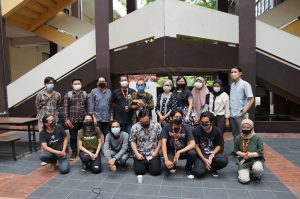“In front of novels, we play the politics of memory,” said Bandung Mawardi (Bilik Literasi) while showing the novels by Father Mangun, Ikan-Ikan Hiu, Ido, and Homa.
He emphasized that this literary work reaffirmed the history of water which was defeated by the history of the land. He said that the novel set in the East could be used to read our water map.
In addition, Kabut, Bandung Mawardi’s nickname, also compares the novel with other disciplines. Father Mangun marked many things related to maritime history, maritime history.
“This novel does not advocate ideas that always think that the spice route is related to tourism, as is currently being done by the government and many communities,” said Kabut at the event entitled Guna Citra: Romo Mangun’s Landscape of Thought at the Duta Wacana Christian University (UKDW) on Tuesday (26/10).
He said that while sitting cross-legged in the courtyard, the fountain pool being his background. Dressed in a red flannel hem with black stripes that looked odd paired with training pants, Kabut explained his thoughts, which had been delayed by a power outage.
The event which was supposed to start at 01.00 p.m in room H-1-1 of the UKDW Didaktos Building was finally moved outside. Although not held in a different place, this activity is an activation of the Y.B. Mangunwijaya Room at the Biennale Jogja XVI Equator #6 2021, which was realized with the support of the History, Theory, Technology Studies and Design FAD Laboratory UKDW, Bilik Literasi, Hatopma Publisher, Yayasan Dinamika Edukasi Dasar dan Pusat Dokumentasi Arsitektur (PDA) and Balai Pelestarian Nilai Budaya D.I. Yogyakarta.
In the outdoor hall of the Didaktos Building, one by one the other speakers, namely Muhidin M. Dahlan (Radio Buku), Mahatmanto (FAD UKDW), and Sri Wahyuningsih (Sekolah Anak Alam) as responders, explained their views on the figure and thoughts of Father Mangun.
Several interesting things emerged along the course of the discussion, such as Muhidin explaining the political-cultural thoughts of Father Mangun. He revealed how privileged the generations of 26, 28, 45 were in the eyes of Father Mangun, judging from several books, notes, and interviews.
Meanwhile, Sri Wahyuningsih saw Father Mangun as a figure full of human views.
“All of his (Father Mangun’s) works must be characterized by humanity. Both Literature, and Architectural designs. It can be seen that Father Mangun wants to humanize humans.”
Towards the last session of discussion, Father Edi was also present as an invitee. He explained his view on the literary phenomenon of Father Mangun.
“Father Mangun’s language has many clauses, and sometimes it violates the standard rules. It more or less shows Father Mangun as a figure that flows, that his imagination is flowing. It’s the human expression in literary form.”
